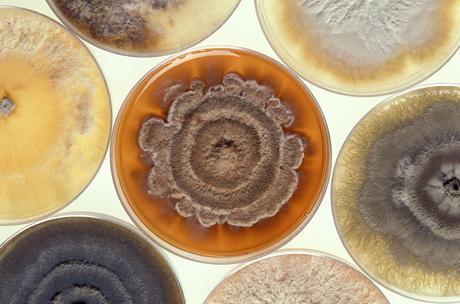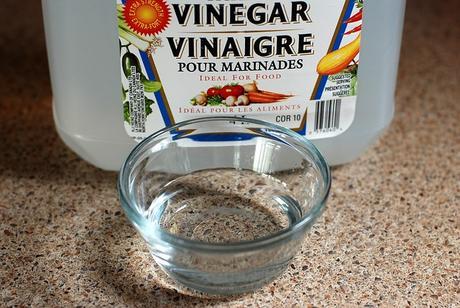
If you’ve discovered some black fuzzy stuff growing in between your bathroom tiles, chances are good you’ve got a mold problem. Now, before rushing out to buy bleach and a hazmat suit, consider this: You don’t have to use of toxic cleaners and chemicals to remove mold. Spores can be killed easily using non-toxic solutions. Here are some non-toxic remedies for safely removing mold in the bathroom.
Grapefruit Seed Extract
- The citric acid in grapefruit seed extract is useful for killing mold. It disinfects and deodorizes too.
- Mix together a solution with a ratio of ten drops of grapefruit seed extract for every cup of water.
- Using a spray bottle, spray the mixture onto any surfaces where mold is visible.
- Let the solution sit. The longer it remains in contact with the surface, the more it will penetrate and kill the source of the mold, keeping it from returning.
- Wipe away the mold.
- Repeat again if necessary.
- You don’t have to rinse away the solution, it can be left to prevent mold growth.
- Don’t throw away leftover solution. You can leave it in the spray bottle and store it away. Grapefruit seed extract has a long shelf life and can maintain potency for a long time.
Tea Tree Oil
- Tea tree oil is antifungal and antibacterial. It is the most effective non-toxic method for killing mold.
- Mix together a solution with a ratio of 1 teaspoon of tea tree oil for every cup of water.
- Note: Be sure the tea tree oil is derived from Melaleuca Alternifolia.
- Using a spray bottle, spray the solution onto any surfaces where mold is visible.
- Alternative: Use a cloth or rag to apply the solution to the surface and scrub until the mold is gone.
- No need to rinse or wipe away the solution because it will prevent mold growth.
- Don’t throw away the solution, tea tree oil can be stored and used a long time afterward.
Baking Soda
- Baking soda is a safe and natural mold killer that deodorizes and absorbs moisture.
- Mix together a solution of baking soda and warm water. Mix thoroughly to until the baking soda completely dissolves.
- Use a spray bottle to spray the solution onto the surface where mold is growing.
- Let the solution sit for a few minutes and then wipe away with a towel or scrub with a dish sponge to remove more mold.
- Repeat if necessary.
- Spray the surface one last time and let it dry, this will help prevent mold growth in the future.
Baking Soda & Liquid Soap (Grout)
- Mix together a paste from one cup of baking soda and one teaspoon of liquid soap. Add water or vinegar slowly until it forms a paste.
- Use your fingers or small brush to work the paste between the tiles and onto the surface of the grout.
- Let the paste sit and then wipe away with a wet cloth or sponge.
Repeat if necessary.
Detergent (Liquid Soap)
- The detergent won’t kill the mold, but is effective in cleaning it away.
- Mix together a solution of warm water and detergent.
- Use the solution to clean away any mold from hard, non-porous surfaces using an abrasive dishwashing sponge.
Hydrogen Peroxide
- Hydrogen peroxide can kill mold because it is antifungal, antibacterial, and antiviral. The bleaching effect is useful for removing mold stains.
- If you’re concerned about the bleaching effect of hydrogen peroxide, test a small spot of the area to clean. Then check for color fading in the material.
- Use a dark spray bottle to spray 3% concentration hydrogen peroxide until the area is saturated.
- Let the hydrogen peroxide sit for ten minutes.
- Scrub the area to remove mold and stains.
- Wipe the surface down with a wet cloth or sponge.
- Repeat if necessary.
- Store the hydrogen peroxide in a dark area since direct light reduces its effectiveness.
Vinegar
- The mild acid in vinegar can kill up to 82% of mold species.
- Use a spray bottle to spray vinegar directly onto surfaces where mold is present.
- Let it sit for one hour.
- Wipe the surface down with a wet cloth or sponge and then allow it to dry completely.
- Any lingering smell should disappear within a few hours.
- You can also mix the vinegar with the juice of one lemon to remove any musty smells.

Lemon Juice
- The natural acidity of lemon juice is useful for killing mold.
- Clean the area with soap and water and then rinse.
- Squeeze the juice of 5 lemons into a small bowl.
- Dip a new dishwashing sponge into the lemon juice and scrub to remove the mold.
Mold growth in the bathroom should be taken care of immediately to prevent respiratory illnesses and allergies. Bathrooms provide the perfect conditions for mold growth because they are regularly warm and humid. Serious mold problems will require more drastic solutions, such as replacing entire walls, and the use of toxic chemicals. Always have mold tested if you begin to suffer respiratory problems.
Since mold needs darkness to grow, be sure your bathroom has plenty of good lighting. Another consideration is a freestanding bath tub to prevent mold growth between the tub and wall tiles. The design of modern dual sink vanities use integrated countertops and vessel sinks, which are easier to clean and less likely to grow mold.
Sources:
About The Author
Cheryl Khan is a passionate blogger who contributes regularly to the Trade Winds Imports blog. She is always on the look out for simple solutions to common problems.
